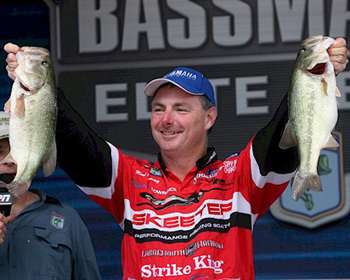
When it comes down to it, fishing a big spoon for deep water bass is still a mystery to many bass anglers. At first glance, it looks like an easy technique — cast it out, let it sink and hop it back.
However, line twist and lost fish often cause inexperienced spoon fishermen to forego the technique. Elite Series pro Mark Menendez has spent years perfecting spoon fishing on his home water of Kentucky Lake. The Paducah, Ky., pro has several tricks to reduce the learning curve when it comes to throwing big spoons for deep bass. "A lot of times when you're structure fishing, you'll start catching fish that are all the same size," Menendez says.
"If I feel like there are some bigger fish in the area, there's one bait I like to throw — a Sexy Spoon." Made by Strike King, the Sexy Spoon is 5 1/2 inches long and resembles the profile of a large shad. "One of the things about this bait is that it has a big profile and a lot of flash so fish can see it from a long distance," he says.
"When you're in groups of bass, there's a lot of competition between the fish, and with a jig or a Texas rigged plastic, the little fish will often beat the big ones to the bait." While a big spoon may weed out bites from smaller bass, it's a well-known fact that after fishing the bait, line twist becomes an issue as the spoon flutters and turns in the deep water.
To combat this problem, Menendez always adds a high-quality barrel swivel to the eye of the spoon. "It can be a big headache if you don't add that barrel swivel," he says. "It's the first thing that I do." Once he has managed line twist, Menendez then focuses on improving his hookup ratio.
If the bass are slapping or nipping at the bait, he'll often add a second treble hook to the offering, positioning it on the split ring at the head of the spoon. "Many times when you're hopping that spoon, the bass will hit the bait and not get hooked.
By adding a treble hook on the front, it gives me more hooking power." If he's looking to increase both the hooking ratio and the appeal of his spoon, Menendez will secure a feathered treble hook to the existing hook on the back of the spoon, just like a trailer hook on a spinnerbait.
"The additional treble hook gives me more chances to get the fish in the boat," he explains. While some spoon anglers like to fish the offering vertically, Menendez prefers to cast the spoon to the top of the structure and work it back into deeper water. He favors a 7- to 7 1/2-foot rod and spools with 17-pound-test fluorocarbon line.
"By using these modifications and putting the extra hooks on there, you're spoon fishing and the percentage of bass you get in the boat will go up," he says.
(Provided by Z3 Media)




